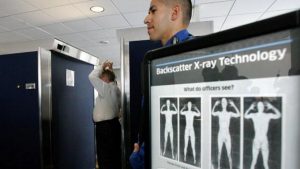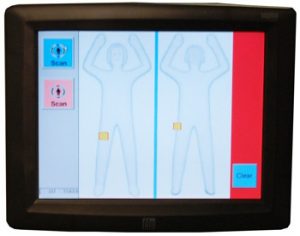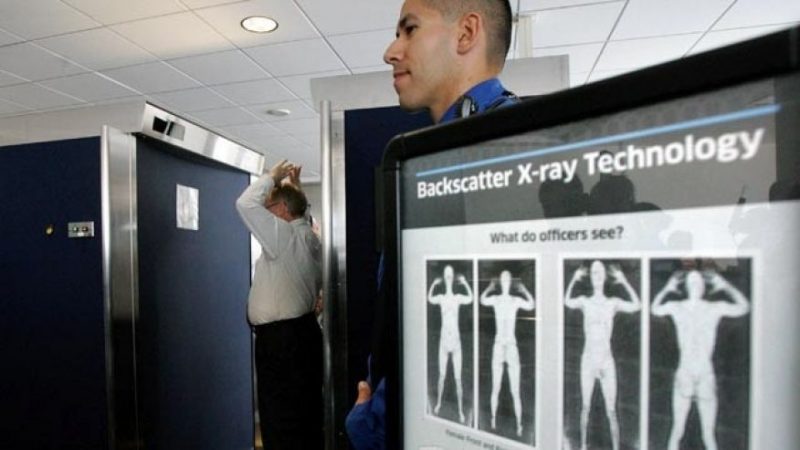 “Next in line. Please step onto the platform. Feet wide apart, place your hand behind your head.”
“Next in line. Please step onto the platform. Feet wide apart, place your hand behind your head.”
*Rotating arm of the scanner moves around you* .
“Ok. Please step out.”
If you travel through the US airports in the past few years, you will notice the security guards saying one or more of these lines.
Each traveller is required to pass through a full body scanner before they are allowed to board the plane.
There are two types, 1) Backscatter X-ray which uses a low-intensity X-ray beam that moves at high speed to scan the entire body including cavities; and
2) Millimeter wave scanners which uses non-ionizing electromagnetic radio waves in the millimeter wave (30-300 gigahertz) spectrum to generate images of what lies directly beneath the clothing and near the skin.
Initially, there were more backscatter X-ray machines in airports; however, in May 2013 the millimeter wave scanners replaced all backscatter X-ray machines in the US.
This change was made to uphold the Federal Aviation Administration and Reform Law of 2012 that stated that all full body scanners operated in airports by the TSA must use Automated Target Recognition software (AIT). What is AIT you may ask? AIT is a software that replaces the picture of the naked body with an animated-like representation.
Here’s how the aviation security used to see with their backscatter X-ray machines.

I’m sure you agree with me that it doesn’t leave much to the imagination.
Now the images produced by the scanner are not as violating –

Now the question is how safe are the full body scanners?
TSA has come under much scrutiny for the implementation of these devices, but what does the movement of this rotating arm means for our heath as it bounces wavelength off our bodies to generate images in an effort to keep us all safe?
According to TSA, the health risks associated with the full body scanners are minimal to none in comparison with using a cell phone or radio, and is way less than what we are exposed to during flying.
However, after much investigation, it was revealed that the ionizing radiation emitted by the backscatter X-ray machines are cancer causing as they damage our cells and DNA.
It can be argued that the result of these investigations is one of the major reasons that TSA opted to replace all backscatter machines with the millimeter wave scanners.
Technically, there has not been enough research and experiments on the millimeter wave scanner to determine that they are safe.
First, a research paper published in 2012 in the journal Radiation Research admits that the safety of millimeter wave body scanners is “difficult-to-impossible to prove using publicly accessible data.”
This means that TSA’s claims on the safety of the scanners are based on their opinion and it is not scientifically proven to be non-hazardous for your body.
Secondly, there is a belief that since long wavelengths belong to a ‘non-ionizing’ class of radiation, they only raise the temperature of your cells and tissues but do not have a harmful effect on your proteins and DNA.
But this is not decisively proven and a Russian paper published in 1993 showed that millimeter waves can have a negative effect on the cellular survival of DNA, RNA, & proteins, and shorten their lifespan.
The truth is the radiation produced by the millimeter wave is used in the treatment of skin cancer, which means that it does have an effect on human cells.
The purpose of applying the millimeter wave to the treatment of cancer is for it to destroy the cancer cells.
Frankly speaking though, these waves have no way to determine if the cells in our body are good or bad.
Let’s think logically for a second, if these waves emitted to our bodies have no way of determining if the cells in our body are good or bad, then simply put won’t these waves destroy the good cells that are present?
Over and over research have shown that thermal changes in our body can change the structure of cells and DNA, and this is exactly the kind of damage wavelengths from the millimeter wave scanners can inflict on our cells.
They have the ability to alter the natural structure of our cells and DNA.
What usually leads to cancer?
Changes in our cells and DNA.
So yes, it may be true that the dosage of the radiation that we are exposed to during the screening process is low and the process is quick, and there is no real proof that using the millimeter wave scanners will cause cancer, but should we just sit there and wait until there is enough evidence to prove that full body scanning at airports are carcinogenic?
Constant exposure increase the risk of cancer!
So what then can you do to in the meantime to protect ourselves?
Say no to the full body scan!
No, not like a protest; just let the TSA officer know that you would like a pat down instead of a full body scan.
It is actually our legal right to choose between the two.
The choice was actually affirmed by the D.C. Court of Appeal in 2012.
Yes, we would prefer to do neither as a pat down can be uncomfortable, but realistically speaking, in the world that we are living in where terrorism is rampant, how do we know who to trust?
Therefore, some form of screening is important. If you are comfortable and have sufficient time before boarding the plane, opt for the pat down and skip the possibility of millimeter waves scanners affecting our health.
After all, prevention is better than cure.
To protect yourself against the radiation, go to the next page and learn about the elixir to boost your immune system –
REFERENCES:
- Congressional Research Services. Airport Body Scanners. Retrieved from https://fas.org/sgp/crs/homesec/R42750.pdf on February 28, 2017.
- Daily Infographic. TSA Gone Wild. Retrieved from http://www.dailyinfographic.com/tsa-gone-wild-infographic on February 28, 2017.
- Knowledge Tree. (2013, July 29). TSA – Full Body Scanner – How Does It Work? [Video File]. Retrieved from https://www.youtube.com/watch?v=L4yENAMD0u0
- USA Today. Scientists: TSA scanners didn’t zap travellers with too much radiation. Retrieved from http://www.usatoday.com/story/news/2015/09/29/tsa-x-ray-radiation-rapiscan-american-science-engineering/73019876/ on February 28, 2017.
About the Author:
Emma Deangela is the best selling author of The Alkaline Diet Program and 80/20 Fat Loss. She has helped over tens of thousands of men and women to lose weight and transform their health with sound nutrition advice. Learn how you can lose weight fast – How to lose weight by adding these alkaline foods.
Which wonderful friends in your life would appreciate this information about radiation from airport scanner?
Please help them by sharing this eye-opening article with each of them using any of the social media and email buttons below.


Leave a Reply